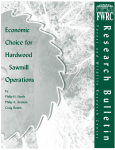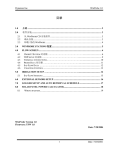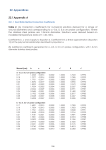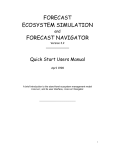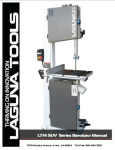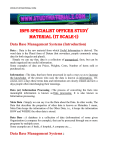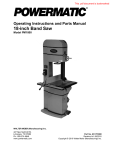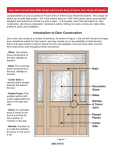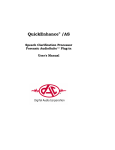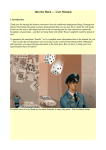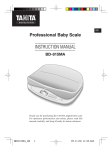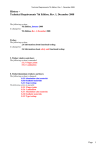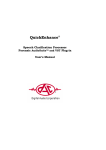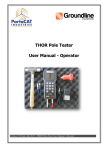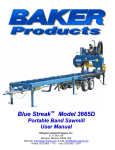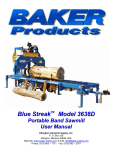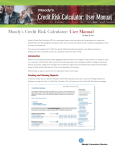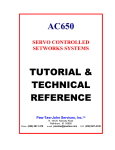Download information - Guyana Forestry Commission
Transcript
QUICK REFERENCE GUIDE FOR THE IMPLEMENTATION OF THE CODE OF PRACTICE FOR WOOD PROCESSING FACILITIES, (SAWMILLING AND LUMBERYARD OPERATIONS) This reference guide is extracted from the Code of Practice for Wood Processing Facilities (Sawmill and Lumberyards) and is expected to provide guidance to the respective stakeholders of the sector to better manage their respective operations. Section A outlines requirements that have to be addressed because they are mandated by the Laws of Guyana or need to be done in order to conform to Government’s policies for sustainable utilization of natural resources. These requirements are referred to as the “must” statements within the Code of Practice. Compliance of management and facilities operations to these requirements will inform the process of a renewal of operating licenses and non-adherence will result in appropriate action being taken against defaulters. Section B details additional requirements or best practice for management that can improve overall efficiency for sawmills and lumberyards. These requirements are referred to as the “should” statements within the Code of Practice. The adherence of management to these requirements will result in the accumulation of small gains at all stages of the operations and a more competitive and profitable operations. A. Mandatory Requirements detailed in the Code of Practice for Wood Processing facilities that are supported by legislation and Government’s policies for sustainable utilization of natural resources. 2.0 Pre-Sawmilling Requirements All wood processing operations must confirm to the requirement of the GFC for forest legality to establish that all lumber produced, must be derived from a legal source. These requirements prescribe the checks of forest operations and controls of supply chains from harvesting to export to confirm that the wood or lumber came from a legal source. Directional felling techniques must be practiced to minimize damage to the residual stand, reduce splitting in logs from felling activities by plunge cutting, improve safety by better control of the tree and improve recovery by ensuring cuts are perpendicular to log length. The ends of logs must be protected with wax, sealed with an appropriate sealant, or insertion of an S-iron to minimize splitting and end checking from occurring if the log will not be processed within 1 week of cutting. Logs must be transported without a long overhang on trailer, as the whipping motion causes splitting at the flex point of the logs which will affect the quality of lumber produced from the log. 3.0 Sawmilling Requirements GFC requirements All sawmilling and wood processing operations must be licensed annually by the GFC and hence will have to confirm to the requirements for forest legality as established by the GFC. Operations involved in export of wood products must confirm to the requirements for forest legality as established by the GFC. Design of sawmill Sawmills layouts and equipment configuration must be designed to achieve the desired output and recovery levels with a minimum disruption to the smooth flow of material through the mill and with the minimum use of labour. The gang rip saw must include an accurate and consistent feed system that adequately ensures the board is fed through the machine in a straight line to produce straight boards. It must have a moveable/ re-moveable fence to aid in straight line ripping. The edger must be equipped with anti-kickback fingers to prevent the boards being thrown back into the operator The Trim or Cross-cut saw must be well guarded to prevent accidents, have sufficient depth of cut and power to adequately and safely cut the size lumber required. Saws must be mounted perpendicular to the end of the piece to ensure truly square cuts are made. Saw blades must be selected and maintained to provide a smooth cut that shows no signs of tear out. Log yard operations Log yard practices are critical for the profitability and competitiveness of wood processing operations; hence the operating practices must focus on maintaining the quality of the log during storage and processing logs as fast as possible. Log yards must be kept clean of debris and vegetation to prevent insect, bacterial and fungal growth that could transfer to the logs. Log yard must be well drained. Logs being stored for extended periods must be waxed/sealed with an appropriate sealant or have an S-iron installed, so as to prevent splitting and end checking from occurring. Logs must be graded prior to processing to identify the first opening face and sawing pattern to be used. Excessive crook, excessive butt flare and any protruding limbs must be removed before the log is loaded onto the carriage. Optimal Log Orientation: Defects must be located when possible towards the edges of the faces. By doing so, most of the defects will be positioned on the edges of the flitches when sawn and can potentially be trimmed or edged off to increase the grade or value yield of the produced lumber. Sawmilling operations The Owners, Managers and Operators must be a part of the well trained workforce knowledgeable about maximizing the efficiency and effectiveness of the equipment, to capitalize on value recovered for sawmilling operations. The Headrig/Primary log breakdown operation must be under the control of a competent /certified operator who is experienced in the operation of the headrig. The saw blade on the headrig must be constantly cooled to ensure that the production volume and the quality of products are maintained. The choice of sawing pattern must be made to balance production volume with quality, to achieve the greatest value in the shortest time, or with the minimum of material and cost. Live sawing must only be used for small logs, defective logs and logs with pronounced sweep or crook. Grade sawing must be the preferred method for sawing medium to high grade logs. This is the technique that is most effective in deriving the greatest net value from most logs. Ends of rough sawn lumber must be sawn perpendicular to the longitudinal axis of the piece and then coated with a properly applied thick end-coating to reduce the likelihood of end-splitting during seasoning, shipment or usage. All industry stakeholders must adhere to the standard thickness sizes for rough sawn lumber specified in Table 1: Specified Sawing size (thickness) for Rough Sawn lumber and Table 1: Specified oversize (maximum) for width size for rough sawn lumber unless they are cutting to meet specified market requirements as detailed in an order/contract. Lengths of Rough Sawn lumber, unless specified differently in a contract, must increase in intervals of 304.8 mm (12”) with a maximum oversize of 152.4 mm (6”). Chainsaw milling must follow the same sawing patterns, safety requirements and guidelines as for sawmilling operations. 4.0 Quality Assurance Documents such as procedures and work instructions must identify and detail the best practices recommended by the company in its operations and records provide the evidence to demonstrate conformity to the recommended practices. Some areas for which records must be maintained are: Inventory records: Raw material -Log and final products. Production record: Supporting Chain of Custody marketing requirements. Personnel records: Employment history, training. Payments, Performance evaluation, OH&S records: Activities, Accidents monitoring. Maintenance records: Machinery, operation and measurement equipment. Permits and licenses Sawmill returns, Wood products sales form Wood product supply form Management must ensure that personnel with the necessary competence are available for the effective and efficient operation of the organization Quality Assurance training must be provided for at least one person in the sawmill, who would work along with sales and assist the head sawyer and sawmill manager in achieving maximum value, and keep sales informed about log quality changes that could affect current or future sales revenue. Maintenance schedules must be of a preventative nature confirming to timeframe and procedures outlined by the manufacturers in equipment manuals. Areas for routine checks and maintenance in addition to those detailed by the manufacturers of equipment are: Steel cables, slings and chains, and ropes used in lifting Greasing of machines and rails to facilitate easier movement Foundation of saws to minimize vibration during use Strength and position of processing tables/carriages Cooling fluids for saws Sharpening and setting of blades and knives. The Saw Doctor must complete a recognized saw doctor course so as to gather the necessary knowledge/competence to be able to effectively perform the operations of saw doctoring. Some of the areas that can promote good saw doctoring practices are: Cleanliness, tidiness, air circulation, and illumination of saw doctoring room. Proper maintenance and storage can prevent the band saw from twisting, stretching, elongating, becoming rusty and dirty, Band saw blades must be stored in dry and clean place, Avoid twisting, the band saw and store like a belt or ribbon with its center part weighted with a weighing load, Saw should be hung with a support its base; hung band saws must not be touching one another, The surface of saws before being stored can be lubricated with oil or grease. Before storing knives, lubricate them with grease or oil, covered with oily paper or other thin paper; the knives are to be stored neatly on the shelf not in contact with each other; Avoid the storing of knives in places contaminated with dust and other dirt in order to prevent knives from becoming rusty. Calibration of measuring instruments and equipment must be done by a competent person or authority, to a schedule outlined by the manufacturer or based on usage. 5.0 Non-Sawmilling Requirements The moisture content of lumber in storage must be controlled as moisture changes in wood are by far the greatest contributors to degrade in wood. The lumber must be allowed to release moisture evenly across the width, length and thickness to minimize the potential for degrade. If lumber dries in an uneven way it will become uneven due to warp and lose grade. All lumber must be sealed at each end with a vapor resistant sealant to prevent it drying out from the ends and stacked under cover, as quickly as possible, within 24 hrs, after coming off the saw. Lumber stacks must be stored under some form of protection from rain, on a clean (free of obstacles to air flow and vegetation that harbors fungus and bacteria), well drained area on blocks at least 12 -18 inches off the ground to allow a free flow of air around the pile. Stickers must be accurately sawn or preferably planed at least ¾ x ¾ inches (19.05mm x 19.05mm) or wider to allow the free flow of air. The ends of each board must be stickered within 2 inches from the ends of the boards to prevent droop and uneven drying. Uneven lengths need to be supported at the ends within the pile as well. Stickers should be placed 12 – 18 inches apart. For mixed lengths in the same stack, short length boards must be stacked together and additional stickers put in place to properly support each piece. Lumber can be stacked in bundles with no stickers only if it is to be delivered or used within one week of sawing. For longer storage all lumber must be stored on stickers in stacks, under cover in a well ventilated and clean area. The storage area must have a hard surface, be well drained, stable and free from sawdust and any other wooden debris. Each stack of lumber must be labeled with the date of stacking so as to allow for adequate drying time. Rough Sawn wood must remain stickered and stacked until it has achieved a moisture content of 30% or less. Only lumber that has been dried to a moisture content of 30% or less should be stored in Racks or without stickers. All lumber for local sale and export must be graded in accordance with the Guyana Timber Grading Rules for Hardwood. The graded wood products must be properly labeled and stacked according to grade, dimension and density/species. Simarupa, Kereti, Ulu, Baromalli, Futui, Iteballi, Maho, Haiariballi, Dukali, Suya, Kurokai, Muneridan, Wadara, Swamp Dalli are examples of wood species that must be chemically treated, by spraying or dipping, as soon as they are converted to rough sawn lumber to prevent attack from fungi and insects. Fungicides and Insecticides to be used in preventative treatment of lumber must be approved by the Pesticides and Toxic Chemicals Control Board. The ends of all dressed lumber must be waxed or sealed with an appropriate sealant so as to prevent splitting and end checking from occurring. All rough sawn lumber to be dressed must be dried to a moisture content of 30% or less before dressing is carried out. All industry stakeholders must adhere to the standard thickness sizes and tolerances specified for Dressed Lumber. Table 3: Specified Thicknesses and Tolerances for Rough Sawn and Dressed Lumber. Lengths of Dressed lumber, unless specified differently in a contract, must increase in intervals of 304.8 mm (12”) with a maximum oversize of 6.35 mm (¼”). 6.0 Social Requirements Employers must comply with the National Insurance and Social Security Act, 15 of 1969 and associate regulations. Employers are advised, in accordance with the Employment of Young Persons and Children Act Cap 99:01, no person UNDER sixteen (16) years must be hired for any type of work within the industry. 7.0 Health & Safety Requirements Wood processing establishments must comply with the Occupational Safety and Health Act. A joint workplace safety and health committee for establishment with more than 20 employees or a workplace safety and health representative appointed for less than 20 employees. Every person at the place of work, whether as an employer, an employee, a self-employed person or a person in control of the workplace, must comply with the Occupational Health and Safety Act. While the obligation for each person is different, all persons must ensure that the way they carry out their work does not interfere with the health and safety of other persons who are present at the place of work. Before commencing work. employers or persons in control must assess conditions likely to affect the health and safety of the employees or themselves, as identified during the risk assessment procedure, and arrange for the provision and use of appropriate Personal Protective Equipment (PPE). All PPE must be regularly inspected and replaced as necessary The following PPE must be provided and used where necessary: a) b) c) d) Safety helmets complying with relevant standard. Hearing protection complying with relevant standard. Eye protection complying with relevant standard. Safety clothing such as safety boots, waterproof clothing, gloves, and reflective safety vest. All clothing should be comfortable and suitable for the work and the weather conditions. Loose clothing which may snag or create a hazard should be avoided and long hair should be contained. Where employees are exposed to inclement weather they should be issued with protective clothing. e) Respiratory protective equipment complying with relevant standard. The employer/management must ensure that safeguards on equipment are in place. If any protective device is removed from a particular machine, a temporary protective device must be substituted and/or notice of the removal must be given to all workers who seek to use the machine. The employer/management must ensure that: Machine guarding must be done at point of operation for circular saws, plain band saws, gang saws and other cutting devices as well as for gears, belts, chains, sprockets and nip points on conveyor belts and rollers, Guards must be maintained in an efficient state and always kept in position while the machinery is in motion, Guard rails are placed on walkways adjacent to operations or crossing over conveyors and production lines, Every hoist, lift, winch must be of good mechanical construction sound material and adequate strength and is thoroughly examined by a competent engineer at least every six months or at an earlier date, if required, A record is to be kept of the date(s) on which examinations and maintenance was done on particular machines, devices and other equipment. The record must be signed and dated by the engineer, Every saw is installed on a well constructed base to reduce vibration, No person is to be stationed at any wood working machine unless he has been adequately trained to work that machine, and Employees between the ages of sixteen (16) and eighteen (18) must always be supervised – irrespective of their training – when operating any class of machinery Signage must be in accordance with international standards and be well known to, and easily understood by workers, visitors and the general public as appropriate. It is the responsibility of the employer/management to ensure that the following signs are in easily visible places where required and is respected and observed at all times: “No Smoking” “High Voltage” “Fire Hazard” “Restricted Areas” The maximum working load which the machine can carry safely must be conspicuously marked on every hoist, lift or winch, Any other sign deemed applicable to the specific circumstance Hazardous areas (electrical rooms, compressor rooms, etc), installations, materials, safety measures, and emergency exits, etc. must be marked appropriately. All vessels that may contain substances that are hazardous as a result of chemical or toxicological properties, or temperature or pressure, must be labeled as to the contents and hazard, or appropriately color coded. Employers must provide training and instruction, including information and supervision to ensure the health and safety at work of their employees. All persons involved in sawmilling must be trained to follow systems of work and work practices that enable them to perform their work in a manner that is safe and without risks to health. Only those persons who have received training and instruction should carry out the work. The training provided and the instruction given must include: a) the work method to be used for sawmilling operations including manual handling and control measures based on the risk assessment to prevent injury. b) the correct use, care and storage in accordance with the manufacturer’s recommendations of PPE, tools and equipment. c) the use of plant and associated equipment including electrical safety and hazardous substances, and d) procedures to be adopted in the event of accident, injury or other emergency. Employers or persons in control must undertake a risk assessment to identify fire hazards. Suitable control measures must be implemented. Evacuation procedures and fire protection equipment and procedures must be established. Adequate lavatory facilities (toilets and washing areas) must be provided for the number of people expected to work in the facility. Toilet facilities must also be provided with adequate supplies of running water, soap, and hand drying devices. Where workers may be exposed to substances poisonous by ingestion and skin contamination may occur, facilities for showering and changing into and out of street and work clothes must be provided. Adequate supplies of potable drinking water must be provided for the purposes of drinking. Water supplied to areas of food preparation or for the purpose of personal hygiene (washing or bathing) must meet drinking water quality standards Workplaces must, to the degree feasible, receive natural light and be supplemented with sufficient artificial illumination to promote workers’ safety and health, and enable safe equipment operation. Emergency lighting of adequate intensity must be installed and automatically activated upon failure of the principal artificial light source to ensure safe shut-down, evacuation, etc. Supplemental ‘task lighting’ may be required where specific visual acuity requirements must be met. Passageways for pedestrians and vehicles within and outside buildings must be segregated and provide for easy, safe, and appropriate access. The employer must ensure that qualified first-aid can be provided at all times. Appropriately equipped first-aid stations should be easily accessible throughout the place of work Eye-wash stations and/or emergency showers must be provided close to all workstations where immediate flushing with water is the recommended first-aid response Sufficient fresh air must be supplied for indoor and confined work spaces. 8.0 Environmental Requirements All establishments must comply with the EPA Act and Regulations through the implementation of an approved Management Plan or Environmental Permit All persons who are responsible for the operation of the premises must be familiar with the permit/plan conditions and manage the operation accordingly. The owner must obtain prior written approval from the approval authority before: changing the processes used at the premises, constructing or removing any structure associated with the premises, increasing the quantity of materials dealt with at the premises from that specified in the permit, or changing the nature of materials dealt with at the premises, in any manner that might cause or substantially increase the emission of a pollutant or noise from the premises. When any accident, breakdown or malfunction of equipment may or does result in the unplanned emission of a pollutant or noise from the premises, the operator must IMMEDIATELY take all practicable action to contain the emission(s) and to minimize adverse environmental impacts Accumulation of sawmill residues, disused equipment, waste oil and general rubbish must be avoided in order to minimize the potential for site contamination, reduce the visual impact of the operation and improve site safety Refuse, including used plant and machinery parts, and domestic refuse, must not be buried on the premises but removed to an approved refuse disposal site. Dust emissions which constitute an environmental nuisance must not cross the boundary of the premises. Roads within the boundary of the premises should be watered or sealed to minimize environmental nuisance and an effective cover to control spillage should be placed over all loads of wood chips and sawdust being removed from the premises. Boiler or furnace utilizing wood residues should only be operated after approval from relevant authority. There must be no open burning on the premises. Sawdust should be captured at source and transported to the sawdust hopper or other storage facility by means which prevents fugitive dust emissions. Waste water discharged must be managed to avoid degrading the receiving water quality. Processed wastewater containing chemical preservatives must be contained as part of a closed loop application system. Noise management provisions and noise level measurements must be carried out by the employer or person in control to ensure compliance with applicable regulations and the recommended practices for noise management and protection. Where the noise level is in excess of the noise exposure limits, engineering control measures must be implemented. Where this cannot be achieved, appropriate hearing protection equipment must be provided to all persons in the vicinity of the operations. Machinery and equipment must be well maintained to minimize noise emissions. Fans, blowers, compressors, generators and exhausts must be fitted with silencers. All hazardous substances must be appropriately stored and handled according Material Safety Data Sheets (MSDS). Fuel, lubricants, chemicals, coolant, waste oil and waste chemicals must be stored in an approved manner (such as in drums or surface tanks located on an impervious bounded area). B. Competitiveness Requirements; ‘Should’ detailed in the Code of Practice for Wood Processing. 2.0Pre-Sawmilling Requirements Market Requirements Investors/wood processors should focus on the following to match the resource to the markets: Focus on niche markets that are lower volume but more dynamic in nature – niche markets tend to be very quality conscious. Flexibility in production at all levels to be able to adapt equipment and techniques to meet the varying and dynamic demands inherent in niche markets. Target markets they can effectively compete in – focus more on markets that have low volumes and high value so as to be able to compete with the big producers who find these small markets difficult to deal with. Product mix selection should be generated based on maximization of value and volume of recovery in the sawing operations. Sawmillers should carefully select what orders and range of sizes they can effectively and profitably produce. The company’s goal should be to look for orders for as wide a range of sizes as possible and develop markets where possible for random length and random width lumber. Logs-Raw Material input The bucking process in forest should match final use/product requirement so as to minimize cut off residues and wastage in trimming process. Care should be taken when handling logs with mechanical handling equipment (eg. Loaders) to prevent any damage. 3.0 Sawmilling Requirements Design of Sawmill The design should be such that it can adapt to producing products based on changes in the market requirements. Careful planning should also be paid to waste handling for slabs and sawdust such that their disposal or movement does not in any way affect the operation of the saws or the health and safety of workers, and utilize the minimum of labor. Use the services of the manufacturers or representatives to come up with an efficient or effective layout that best matches your requirements – they should be able to provide specifications, layouts and designs that will minimize the chances of a costly mistake or bottlenecks in the system. The user manual for equipment should be taken into consideration in making decisions at all times. The typical sawmill system should consist of a single or multiple headrigs feeding to one or more edgers, or to an edger and grade resaw. Computerized setworks should be fitted to allow consistent product target sizing. The carriage should be strong enough to support the weight of logs that it is designed to cut and should be fitted with power assisted log handling equipment to be able to rapidly turn, clamp or raise/outset either end of the log. Gang ripsaws should have enough blades to cut both sides of each piece being sawn from the wider board. The trim station should have in-feed and out-feed tables and length measuring system that can easily be referenced against the piece to be trimmed. Logs should be cleaned before being put on the mill. Log in-feed deck should be controlled by the sawyer. It should be able to hold a stock of logs for the mill, sufficient to prevent waiting for more logs to be loaded. Sawdust and slab removal system should be mechanized and operate continuously to prevent a buildup of waste that could block or hamper the operation of the mill or edger. Transfer decks should be installed to shift material to the side to allow flexibility in layout or sorting of product. The green chain should be integrated with crosscut/trim saws to allow easy trimming or defecting by length. Log yard Operations The practice of just–in–time delivery to the mill should be implemented where possible through effective planning, to minimize time between felling and sawing, so as to reduce tension in the log Proper log inventory management should be implemented through the practice of a first-in firstout policy to reduce time to processing and prevent degrade of logs. Logs should be sorted by species, length, diameter, and quality class/grade to optimize log characteristics to end product requirements e.g. – use smaller diameter logs for box heart cants, or larger logs for quarter sawing lumber to improve recovery. Logs should be stacked in small piles, so as to avoid the lower stacked logs being in contact with muddy and sandy soil for extended period and as much as possible, maintained wet to retain the moisture in the log so as to prevent the log from drying out. Debarking, bucking and/or washing logs before loading onto carriage to ensure cleanliness should be done to facilitate faster processing time for the log and longer life of the saw blade. Logs should not be cut into large cants off the heart centre as the cant will bow towards the bark side and lead to the production of low grade warped lumber (crook is a typical feature). In splitting any log it should always be cut in line with the heart of the log into equal or unequal halves or quarters (dependent on size). Small logs should be sawn into 1 inch boards to minimize the effect of tension – 1 inch material can be stacked with weights on top to “straighten” the piece while drying. Small logs should be live sawn to get the widest boards possible out of the log to be able to edge for the most volume of clear lumber. Live sawing also allows higher production rates by minimizing turning and reducing the number of cuts to maximize production. Logs should be graded by the quality of the four sawing “faces” on the outside of the log. The faces of the log should be selected based on the defects on the outside of the log. To improve productivity and sawing practices the log grader should pre-mark the log indicating the face or location of the first cut prior to debarking because it is difficult to see the log defects after debarking. Sawmilling Operations Operators, supervisors, managers and owners should be trained in specific aspects of the operation to ensure they can comply with the guidelines and practices set out in this Code, as well as in log and lumber grading so they can make the necessary sound decisions required to maximize the value obtained from the log. In order to make the right decision in maximizing the value of the lumber obtained from a log, the following should be considered during primary log breakdown/headrig/resaw operataions: Log selection for grade and size to best match the market demand and lumber sizes to be cut. First opening face solution. Deciding when to turn to maximize the grade on each face. Deciding where in the log to saw different sizes from. What size heartwood cant to send to a resaw to optimize volume and grade production. The choice should be based on whatever balance of production, recovery and lumber price gives the highest overall return. Logs with pronounced sweep or crook should also be cut into short lengths and 1 inch material so that variations in density along the length of the boards can be stabilized through drying under weights to keep the lumber straight. When logs are dried-out, they should be cut into 1 inch material as there is a better possibility of removing the warp caused by tension in the drying process through applying weight to the lumber stack, humidifying the lumber. For cant sawing, equal amounts of lumber should be taken from the each side so that the heart is centered to help the cant keep straight. Care should be taken in high tension species to not saw too deep on any one face, but to remove the sapwood/tension wood on all four faces evenly Cant sawing should be used to maximize the overall production in mills that have secondary resaw capacity as it allows the best grade to be taken off the outside of the log by the headrig and the more defective, lower grade centre to be sent to the resaw for rapid breakdown. When choosing to produce quartersawn lumber, the owner should ensure that they are properly compensated for their loss of production and recovery from the round log by the price they are offered for the lumber. This technique should only be used to meet customer requirements for more stable lumber or for a specific “look” to the wood, typically a flat, “Clean,” straight grained face with some small flecks in the face of the boards. Quarter sawing should only be used as an option to either match specific market requirements or to prepare big logs to be handled by smaller log capacity sawmills. Customers should be clear with sawmills as to what type of quartersawn material they want. The best lumber is found in the “jacket” of the log (the area between the heart and the bark/sapwood), therefore the operator should concentrate on getting the most grade and volume out of the best part of the log. The operator should focus on having the defects (knots, splits etc) on the outside of the log being to the edge of the flitches so that it can easily be edged off to produce high grade lumber. For the worst opening face solution the operator should only saw deep enough on that face to produce a flat base to support the log when it is turned 180 degrees to the opposing better face to allow him to cut in line with the bark on that face. Logs should always be cut from the small end to the large end to give the operator a better reference when making the first cuts and arriving at the final cant dimensions. Mill management should determine if optimizing to a specific grade rule requirement is the appropriate objective, for a sawmill producing lumber for furniture or cabinet shop would achieve greater value and recovery through optimization of random width Edgers should have random width capability, for fixed width edging will always result in the operator over edging the lumber. Rough planing should produce a product that is more uniform in size which will improve the performance of secondary machines. 4.0 Quality Assurance Management should determine knowledge and/or skills an employee would need to be considered competent to perform a particular job and then determine if the employee performing the job possesses that knowledge or skill. If not, considered it as a training need and it should be addressed. Saw should be hung with a support of its base; hung band saws must not be touching one another. 5.0 Non-Sawmilling Requirements Blocks should be 12 (304.8mm) – 24 inches (609.6mm) apart and stickers should be aligned with the blocks and with the rows above in the lumber piles to prevent distortion of the lumber. The softer the wood and thinner the pieces, the smaller the gaps between the stickers. The lumber stacks should be restricted to a width of 1,800 mm. as wider stacks may lead to uneven/insufficient air flow and inconsistent drying across the stack. Stacks should be orientation relative to wind direction to facilitate the free flow of air through and around the stack, and easy movement and handling. 7.0 Safety and Health Requirements The employer, employees and their representatives should consult with each other to determine safe systems of work based on the assessment of the risk and determining the provision of safeguards. All safety clothing such as safety boots, waterproof clothing, gloves, and reflective safety vest should be comfortable and suitable for the work and the weather conditions. Loose clothing which may snag or create a hazard should be avoided and long hair should be contained. Where employees are exposed to inclement weather they should be issued with protective clothing. The employer should monitor the systems of work and provide refresher training to ensure that safe systems and work practices are being followed, including the use of PPE. Only those persons who have received training and instruction should carry out the work. Equipment and installations requiring servicing, inspection, and/or cleaning should have unobstructed, unrestricted, and ready access Hand, knee and foot railings should be installed on stairs, fixed ladders, platforms, permanent and interim floor openings, loading bays, ramps, etc. Openings should be sealed by gates or removable chains Covers should, if feasible, be installed to protect against falling items Measures to prevent unauthorized access to dangerous areas should be in place Appropriately equipped first-aid stations should be easily accessible throughout the place of work and eye-wash stations and/or emergency showers should be provided close to all workstations where immediate flushing with water is the recommended first-aid response. Air distribution systems should be designed so as not to expose workers to draughts Mechanical ventilation systems should be maintained in good working order. Point-source exhaust systems required for maintaining a safe ambient environment should have local indicators of correct functioning. The temperature in work, rest room and other welfare facilities should, during service hours, be maintained at a level appropriate for the purpose of the facility. 8.0 Environmental Requirements If all other feasible, beneficial uses have been considered, wood waste should be disposed of through controlled incineration. Extraction systems should be provided for locations at which these particulates are formed, including saws, sanding, shaping, and routing machines. Cyclones or bag filters are typically employed to remove particulates from the air stream before release. Good housekeeping practices should also be employed to minimize dust generation. Roads within the boundary of the premises should be watered or sealed to minimize environmental nuisance and an effective cover to control spillage should be placed over all loads of wood chips and sawdust being removed from the premises. A boiler or furnace utilizing wood residues should only be operated if the exhaust gases are treated using efficient particulate removal equipment agreed to by the approving authority or, alternatively it can be demonstrated that efficient combustion is being achieved. There should be no open burning on the premises. Storm water from process areas should be segregated from storm water in non-process areas. Operators should seek to reduce the noise impact from chainsaws as far as practicable by minimizing the time chainsaws are required to be used and avoiding the use of chainsaws during sensitive periods of the day. All bends in the dust extraction system ducting should be `easy' bends; sharp or right angle bends should not be used. All machines with a tendency to produce vibrations should be mounted on vibration dampeners and mounted on individual foundations free of the rest of the floor. Trucks approaching and leaving the premises should be routed to avoid residential areas wherever practicable. Machinery maintenance operations should be undertaken in such a manner so as to capture any fluids released for reuse or appropriate disposal. Lights used to illuminate any areas of the site for security or any other reason should be angled or shaded in such a manner so that the light does not directly illuminate any nearby residential premises. The location, siting and design of new developments or changes to existing operations should be in accordance with this Code and relevant legislation, and operate without conflict with the adjacent uses.


















